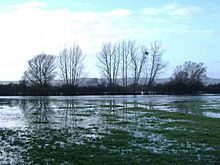Walmore Common facts for kids
| Site of Special Scientific Interest | |

Walmore Common
|
|
| Area of Search | Gloucestershire |
|---|---|
| Grid reference | & |
| Coordinates | 51°50′01″N 2°22′15″W / 51.833476°N 2.370743°W |
| Interest | Biological |
| Area | 57.78 hectare |
| Notification | 1966 |
|
Designations
|
|
| Official name: Walmore Common | |
| Designated: | 5 December 1991 |
|---|---|
| Reference #: | 538 |
Walmore Common is a special nature reserve in England. It covers about 57.78 hectares (that's like 142 football fields!). You can find it on the flat land next to the River Severn, west of Gloucester.
This area is very important for nature. It was named a Site of Special Scientific Interest (SSSI) in 1966. This means it's a protected place because of its unique plants, animals, or geology. Walmore Common is also listed as a Key Wildlife Site in the local plan for the Forest of Dean.
Because it's a wetland, Walmore Common is recognized as a very important place around the world. It's a Ramsar site, which is a special title for wetlands that are important for water birds. It's also a Special Protection Area (SPA) because it's a safe home for wild birds, as set out by a European rule.
Where is Walmore Common?
This special place is in the area around the River Severn. It often floods in the winter, which is normal for this type of land. Walmore Common is low-lying and has two main parts.
Underneath the common is the only large area of "peat" in Gloucestershire. Peat is a type of soil made from old, partly decayed plants. This makes the area a very important wetland for both plants and birds. The land here includes different types of grassy areas. Some are natural, some have been changed by farming, and some are marshy. There are also open water ditches, which are like small canals.
Amazing Plants
The eastern part of Walmore Common has lots of wavy hair grass, marsh foxtail, and creeping bent grass. In areas where the grass has been changed by farming, you'll find perennial rye grass and Timothy grass.
The northern part of the common is mostly marshy. Here, you can see different types of rush and sedge plants. You might also spot pretty flowers like bog pimpernel and ragged robin.
The ditches at Walmore Common are very important. They are home to many wetland plants, including a lot of flote grass and several types of pondweeds. Some rare plants grow here too, like the tubular water dropwort.
Winter Home for Birds
Walmore Common is super important in winter. Many wild birds come here to feed and rest. These include beautiful Bewick's swans, wigeon, gadwall, and shoveller ducks. It's a busy and noisy place when these birds arrive!

